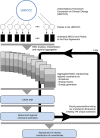Understanding the origin of Paris Agreement emission uncertainties
- PMID: 28585924
- PMCID: PMC5467211
- DOI: 10.1038/ncomms15748
Understanding the origin of Paris Agreement emission uncertainties
Abstract
The UN Paris Agreement puts in place a legally binding mechanism to increase mitigation action over time. Countries put forward pledges called nationally determined contributions (NDC) whose impact is assessed in global stocktaking exercises. Subsequently, actions can then be strengthened in light of the Paris climate objective: limiting global mean temperature increase to well below 2 °C and pursuing efforts to limit it further to 1.5 °C. However, pledged actions are currently described ambiguously and this complicates the global stocktaking exercise. Here, we systematically explore possible interpretations of NDC assumptions, and show that this results in estimated emissions for 2030 ranging from 47 to 63 GtCO2e yr-1. We show that this uncertainty has critical implications for the feasibility and cost to limit warming well below 2 °C and further to 1.5 °C. Countries are currently working towards clarifying the modalities of future NDCs. We identify salient avenues to reduce the overall uncertainty by about 10 percentage points through simple, technical clarifications regarding energy accounting rules. Remaining uncertainties depend to a large extent on politically valid choices about how NDCs are expressed, and therefore raise the importance of a thorough and robust process that keeps track of where emissions are heading over time.
Conflict of interest statement
The authors declare no competing financial interests.
Figures





References
-
- UNFCCC. FCCC/CP/2015/L.9/Rev.1: Adoption of the Paris Agreement UNFCCC (2015).
-
- Mace M. J. Mitigation commitments under the Paris Agreement and the way forward. Climate Law 6, 21–39 (2016).
-
- Rogelj J. et al.. Paris Agreement climate proposals need a boost to keep warming well below 2 °C. Nature 534, 631–639. - PubMed
-
- UNFCCC. FCCC/CP/2016/2: Aggregate Effect of the Intended Nationally Determined Contributions: An Update-Synthesis Report by the Secretariat UNFCCC (2016).
-
- UNFCCC. FCCC/CP/2015/7: Synthesis Report on the Aggregate Effect of the Intended Nationally Determined Contributions UNFCCC (2015).
Publication types
LinkOut - more resources
Full Text Sources
Other Literature Sources

